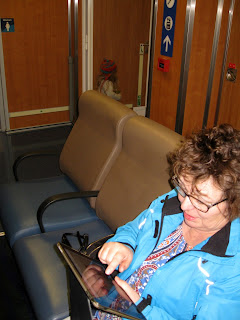Home Comfort
Wool, cotton, plastic; hand knitting.
Chrome Island as seen from Blue Shift's deck
2 years ago my husband and I took a month to sail around Vancouver Island. I took a knitting project to work on every day. I wanted to feel what it was like for the ones who stayed at home to be encouraged, implored and urged to use every spare moment to knit garments for those fighting overseas.
In preparation for the voyage, I went through my stash gathering up all yarns in 'serviceable' colours resolved to use only what I had to follow the wartime mantra of 'making do.'
Provisioning and refueling stop.
During WWII, the Royal Airforce put out a call out for more scarves for plane crews. Planes were getting larger, flying higher and for longer creating long periods of bitterly cold conditions for crew members in cramped, noisy quarters. My grandmother Florence must have been pleased to be able to make something to help her 3 boys in the airforce, something to help keep them warm and comforted knowing someone at home was thinking of them.
Another provisioning stop is a chance to lay out and see what I have knit so far.
I had in mind to make one long, long scarf to suggest the idea of 'mindless knitting.' When both hands are engaged in an activity the mind is free to wander, to get into the zone where there is a comforting flow back and forward between both sides of the brain. In this state, the emotions are calmed and one loses the ability to keep track of time. Knitting becomes a soothing, timeless activity.
Florence would have found great comfort in getting lost in such a revery where she could process her trauma, calm her grief-weary mind and take comfort in caring for her boys while publically appearing to support the war effort.
Knitting is one of the few activities that can be picked up and worked on when it is smooth sailing and can also be thrown down without harm when there is a crisis to manage.
I can knit when it is cold and sunny though every so often I need to hold a hot cup of tea to warm my hands.
I can knit when it is hot and sunny.
The wool doesn't mind getting wet with rain or salt water.
The colours I work with have several layers of meaning. During WWI and WWII each military force had its own distinctive colours: airforce blue, navy blue which is almost a black, and army khaki yellow. In European cultures, black is the colour of death, grief, and mourning and blue is associated with depression. The personal levels of meaning are black for Florence's grief in losing her husband, eldest son and a brother-in-law to war, airforce blue as a reminder of her 3 sons risking their lives in the airforce, Khaki yellow of infantry man's uniform is a reminder of her fiance away fighting.
Installation
I had in mind this endless knitting would unroll throughout the room I created. But no matter how I placed the knitting it didn't work. It didn't create the mindless knitting revery feeling. I ended up stacking up folds of knitting on the ground in front of the chair. It gets the idea across but I must admit it does not have the impact I thought it would. I thought this work would be the strongest one out of the 10 items in the room. As it turns out, and to my surprise, other works have a stronger impact which I will talk about in later posts.
Here is the 'Home Comfort' story from the booklet produced for this exhibition.
The WWII War Office's request for knitted garments known a 'home comforts' provide Florence with the opportunity to publically appear to be supporting the war effort. Privately, knitting gave her time to grieve over her family's decimation - the death's of her husband and eldest son; the absence of two sons away at war. Florence worked in a conflicted state to rationalise and emotionally resolve the duality of supporting the war effort while sacrificing her sons. She had to come to terms with enabling her children to put their lives at risk while battling the strength of the mother-child bond. Florence took to knitting to physically keep her sons warm, emotionally connect with them, do her patriotic duty and provide a means of processing the traumas of war. Endless knitting became a repeated prayer, a meditative chant of 'knit one purl one,' a mantra to calm a battle-weary mind - a home comfort.

















































